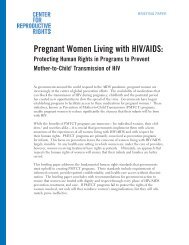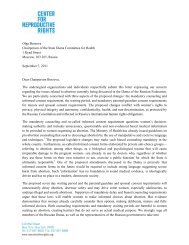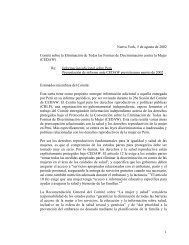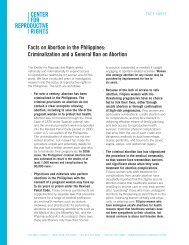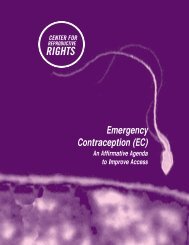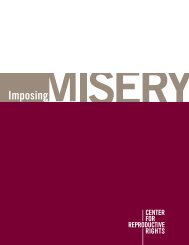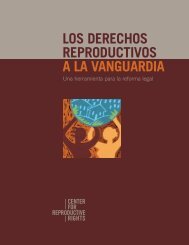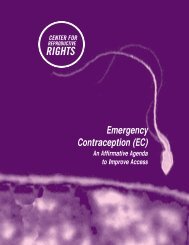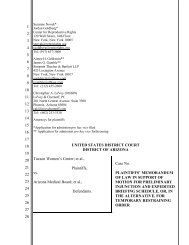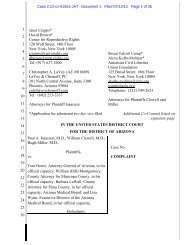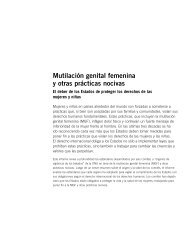The Harmful Impact of the Philippine Criminal Abortion Ban
The Harmful Impact of the Philippine Criminal Abortion Ban
The Harmful Impact of the Philippine Criminal Abortion Ban
You also want an ePaper? Increase the reach of your titles
YUMPU automatically turns print PDFs into web optimized ePapers that Google loves.
Endnotes1 Republic <strong>of</strong> <strong>the</strong> <strong>Philippine</strong>s, National StatisticsOffice, <strong>Philippine</strong>s in Figures 2010 1, 23, http://www.census.gov.ph/data/publications/2010PIF.pdf.2 Const. (1987), Art. III, § 5 (Phil.) [hereinafterPhil. Const.].3 Id. Art. II, § 6.4 Leandro Heriberto Fernandez, A BriefHistory <strong>of</strong> <strong>the</strong> <strong>Philippine</strong>s 310-312 (1919); seeid.5 National Commission on <strong>the</strong> Role <strong>of</strong> FilipinoWomen (NCRFW), Reproductive Health,Responsible Parenthood and PopulationDevelopment Bill Situationer 4 (2009), http://www.ncrfw.gov.ph/index.php/legislativeadvocacy/58-advocacy-reproductivehealth/79-advocacy-reproductive-healthsituationer?format=pdf;see also, Republic<strong>of</strong> <strong>the</strong> <strong>Philippine</strong>s, National Statistics Office,2000 Census: Additional Three PersonsPer Minute, http://www.census.gov.ph/data/pressrelease/2003/pr0323tx.html; CentralIntelligence Agency, <strong>The</strong> World Fact Book,<strong>Philippine</strong>s, https://www.cia.gov/library/publications/<strong>the</strong>-world-factbook/geos/rp.html(follow hyperlink under “People”) (lastaccessed June 18, 2010).6 Asia Safe <strong>Abortion</strong> Partnership, Countrypr<strong>of</strong>ile –<strong>Philippine</strong>s, http://www.asap-asia.org/country-pr<strong>of</strong>ile-philippines.html (go to “Briefhistory <strong>of</strong> <strong>the</strong> law”).7 Revised Penal Code (1930), Act No. 3815(Phil.) [hereinafter Revised Penal Code].8 Id.; see also, Charles Sumner Lobingier,Napoleon and His Code, 32 Harv. L. Rev. 114,128 (1918).9 Revised Penal Code, supra note 7, Arts.27, 256-9; see also, Asia Safe <strong>Abortion</strong>Partnership, Country pr<strong>of</strong>ile –<strong>Philippine</strong>s,supra note 6 (go to “Law related to abortion”)(last accessed, June 18, 2010).10 Revised Penal Code, supra note 7, Art. 11(4).11 Id. Art. XII.12 Phil. Const., supra note 2, Art. II, § 12.13 Id.14 NCRFW, Report on <strong>the</strong> State <strong>of</strong> FilipinoWomen 2001-2003 xxii (2004).15 An Act Expanding <strong>the</strong> Definition <strong>of</strong> <strong>the</strong> Crime<strong>of</strong> Rape, Reclassifying <strong>the</strong> Same as a CrimeAgainst Persons, Amending for <strong>the</strong> PurposeAct No. 3815, as amended, o<strong>the</strong>rwise knownas <strong>the</strong> Revised Penal Code, and for O<strong>the</strong>rPurposes, “<strong>The</strong> Anti-Rape Law <strong>of</strong> 1997,” Rep.Act No. 8353 (1997) (Phil.), available at http://www.chanrobles.com/republicactno8353.htm.16 An Act Providing Assistance and ProtectionFor Rape Victims, Establishing for <strong>the</strong> Purposea Rape Crisis Center in Every Province andCity, Authorizing <strong>the</strong> Appropriation <strong>of</strong> Funds<strong>the</strong>refore, and for O<strong>the</strong>r Purposes, “RapeVictim Assistance and Protection Act <strong>of</strong> 1998,”Rep. Act No. 8505 (Phil.), available at http://subicrapecase.wordpress.com/full-text-<strong>of</strong>republic-act-8505-rape-victim-assistance-andprotection-act-<strong>of</strong>-1998/.17 NCRFW, Bill Situationer, supra note 5;NCRFW, Report on <strong>the</strong> State <strong>of</strong> FilipinoWomen 2001-2003, supra note 14, at xvii.18 See World Health Organization (WHO),Women’s Health Western Pacific Region 5(2001), http://www.wpro.who.int/internet/files/pub/360/1.pdf [hereinafter WHO, Women’sHealth Western Pacific Region]; see also,United States Agency for InternationalDevelopment (USAID), Health PolicyInitiative, Inequalities in <strong>the</strong> Use <strong>of</strong> FamilyPlanning and Reproductive Health Services:Implications for Policies and Programs(2007), http://www.healthpolicyinitiative.com/Publications/Documents/Inequalities%20in%20Use%20<strong>of</strong>%20Family%20Planning%20final%202-8-07%20bw.pdf.19 Id.20 WHO, Model List <strong>of</strong> Essential Medicines(16 th ed., updated) (Mar. 2009), http://www.who.int/medicines/publications/essentialmedicines/Updated_sixteenth_adult_list_en.pdf.21 Misoprostol in Obstetrics and Gynaecology,http://www.misoprostol.org (last visited June16, 2010).22 Alan Guttmacher Institute (AGI), MeetingWomen’s Contraceptive Needs in <strong>the</strong><strong>Philippine</strong>s, 1 In Brief 2 (2009) [hereinafterAGI, Meeting Women’s Contraceptive Needsin <strong>the</strong> <strong>Philippine</strong>s], http://www.guttmacher.org/pubs/2009/04/15/IB_MWCNP.pdf.23 David A Grimes et al., Unsafe <strong>Abortion</strong>: APreventable Pandemic, 4 WHO Sexual andReprod. Hlth J. 4 (2006). http://www.who.int/reproductivehealth/topics/unsafe_abortion/article_unsafe_abortion.pdf.24 Id.25 Interview with former Secretary <strong>of</strong> <strong>the</strong><strong>Philippine</strong> Department <strong>of</strong> Health (DOH), MetroManila (Feb. 20, 2009).26 AGI, Meeting Women’s Contraceptive Needsin <strong>the</strong> <strong>Philippine</strong>s, supra note 22, at 3.27 Id. at 2, 3.28 Id. at 2.29 NCRFW, Report on <strong>the</strong> State <strong>of</strong> FilipinoWomen 2001-2003, supra note 14, at xv;Fatima Juarez, et al., AGI, <strong>The</strong> Incidence<strong>of</strong> Induced <strong>Abortion</strong> in <strong>the</strong> <strong>Philippine</strong>s:Current Level and Recent Trends 31 Int’lFamily Planning Perspectives 140-149(September 2005), http://www.guttmacher.org/pubs/journals/3114005.pdf [hereinafter<strong>The</strong> Incidence <strong>of</strong> Induced <strong>Abortion</strong> in <strong>the</strong><strong>Philippine</strong>s: Current Level and Recent Trends].30 AGI, Meeting Women’s Contraceptive Needsin <strong>the</strong> <strong>Philippine</strong>s, supra note 22, at 2.31 AGI, Unintended Pregnancy and Induced<strong>Abortion</strong> in <strong>the</strong> <strong>Philippine</strong>s: Causesand Consequences 4 (2006), http://www.guttmacher.org/pubs/2006/08/08/<strong>Philippine</strong>sUPIA.pdf.32 Id.33 AGI, Meeting Women’s Contraceptive Needsin <strong>the</strong> <strong>Philippine</strong>s, supra note 22, at 2.34 Id.35 See Asian Development <strong>Ban</strong>k (ADB),Paradox and Promise in <strong>the</strong> <strong>Philippine</strong>s, AJoint Country Gender Assessment 67-68(2008) (see boxes 6.1. and 6.2), http://www.adb.org/Documents/Reports/Country-Gender-Assessments/cga-phi-2008.pdf. Most womenin <strong>the</strong> <strong>Philippine</strong>s live in a state <strong>of</strong> reproductiveinsecurity which may be explained in terms<strong>of</strong> <strong>the</strong> “risk,” “vulnerability” and “shock” towhich <strong>the</strong>y are exposed. Development expertshave defined risk as “uncertain events thatcan damage well-being” (box 6.1, p. 67);“insecurity” describes <strong>the</strong> “exposure to risk,and <strong>the</strong> resulting possibility <strong>of</strong> a decline inwell being following exposure to <strong>the</strong> risk;”“vulnerability” implies <strong>the</strong> level <strong>of</strong> “resilienceagainst a shock” (box 6.1, p. 67); and “shock”refers to <strong>the</strong> “event triggering <strong>the</strong> decline” (box6.1, p. 67) in well being.36 WHO, World Health Statistics 2010 26, 66(2010), http://www.who.int/whosis/whostat/EN_WHS10_Full.pdf.37 Id.38 AGI, Meeting Women’s Contraceptive Needsin <strong>the</strong> <strong>Philippine</strong>s, supra note 22, at 2.39 Id.40 Id.41 WHO, World Health Day, Safe Mo<strong>the</strong>rhood:April 7, 1998 (1998) (citing WHO, Care forPostabortion Complications: Saving Women’sLives, 24 Population Reports (September1997)); see e-mail from Executive Director<strong>of</strong> a Metro Manila-based women’s healthorganization to Melissa Upreti, Senior RegionalManager and Legal Advisor to Asia, Centerfor Reproductive Rights, New York (Nov. 12,2009, 3:55pm EST) (on file at <strong>the</strong> Center forReproductive Rights).42 AGI, Meeting Women’s Contraceptive Needsin <strong>the</strong> <strong>Philippine</strong>s, supra note 22, at 2.43 WHO, Women’s Health Western PacificRegion, supra note 18, at 280.44 Phil. Const., supra note 2, Art. II, § 15.45 Id. Art. XIII, §§ 11, 12, 14.46 Id. Art. II, § 15.47 Id. Art. XIII, § 11.48 Id. Art. XIII, § 14.49 Id. Art. XIII, § 12.50 <strong>Philippine</strong>s National Economic andDevelopment Authority (NEDA), Medium-Term <strong>Philippine</strong> Development Plan 2004-2010170 (2004), http://www.neda.gov.ph/ads/mtpdp/MTPDP2004-2010/PDF/MTPDP%202004-2010%20NEDA_Chapterx12_Poor.pdf.51 Id.52 Id. at 12.53 DOH, <strong>Philippine</strong> Reproductive Health Program<strong>of</strong> 1998, Admin. Order 1-A 1998 (1998)(Phil.), § III, http://www.doh.gov.ph/files/ao1a-98.pdf (last accessed June 16, 2010)[hereinafter <strong>Philippine</strong> Reproductive HealthProgram <strong>of</strong> 1998].54 Id.; see, e.g., NEDA, Medium-Term <strong>Philippine</strong>Development Plan 2004–2010, supra note 50,at 170.55 DOH, <strong>Philippine</strong> Reproductive Health Program<strong>of</strong> 1998, supra note 53, at 2.56 Id.57 DOH, Prevention and Management <strong>of</strong> <strong>Abortion</strong>and its Complications, Admin. Order No. 45-Bs. 2000 (2000) (Phil.) (on file at <strong>the</strong> Centerfor Reproductive Rights) [hereinafter PMACPolicy].58 Id. §I.59 Id.60 Id.61 Id.62 DOH, Family Planning Program, at 1, http://www.doh.gov.ph/node/1023/pdf (last accessedJune 3, 2009); former <strong>Philippine</strong>s PresidentGloria Macapagal-Arroyo, Statement <strong>of</strong>Support to <strong>the</strong> International Conferenceon Population and Development (Mar. 22,2005), http://www.popcom.gov.ph/featured_documents/pgma_icpd.pdf.63 Republic <strong>of</strong> <strong>the</strong> <strong>Philippine</strong>s, Commissionon Population, http://www.popcom.gov.ph/(follow “about us” hyperlink) (last accessedJune 16, 2010).64 Id.65 Id.66 Romeo B. Lee et al., <strong>The</strong> influence <strong>of</strong> localpolicy on contraceptive provision and use inthree locales in <strong>the</strong> <strong>Philippine</strong>s, 17 Reprod.Hlth Matters 99-107.67 DOH, Safe Mo<strong>the</strong>rhood Policy, Admin. OrderNo. 79 s. 2000 (2000), § 3 (Phil.), http://www.doh.gov.ph/files/ao79.pdf.68 DOH, Implementing Health Reforms for RapidReduction <strong>of</strong> Maternal and Neonatal Mortality,Admin. Order No. 0029-2008 (2008), § III(Phil.) [hereinafter Implementing HealthReforms for Rapid Reduction <strong>of</strong> Maternal andNeonatal Mortality], http://home.doh.gov.ph/ao/ao2008-0029.pdf.69 DOH, Women’s Health and Safe Mo<strong>the</strong>rhoodProject, available at http://www2.doh.gov.ph/safemo<strong>the</strong>rhood/safemo<strong>the</strong>rhood_alpha_whsmp.htm; id.70 DOH, Implementing Health Reforms for RapidReduction <strong>of</strong> Maternal and Neonatal Mortality,supra note 68, § IV(4)(a)-(d).71 DOH, <strong>The</strong> Fourmula One for Health: <strong>The</strong>Road Map for Health Sector Reforms in<strong>the</strong> <strong>Philippine</strong>s 2005-2010 (Phil.), availableat http://www.scribd.com/doc/13885214/<strong>The</strong>-Fourmula-One-for-Health-DOH; id.72 DOH, Adolescent and Youth Health Policy,Admin. Order No. 34-A s. 2000 (2000) (Phil.)[hereinafter Adolescent and Youth HealthPolicy], http://www.doh.gov.ph/files/ao34A-00.pdf; DOH, Adolescent and Youth HealthDevelopment Program (Phil.) [hereinafterAYHDP], available at http://www.doh.gov.ph/programs/adolescent_health/ayhdp.html.73 DOH, AYHDP, supra note 72.74 DOH, Adolescent and Youth Health Policy,supra note 72, § 2; DOH, AYHDP, supra note72, Mission.75 DOH, Adolescent and Youth Health Policy,supra note 72, § III (9); DOH, A Guidebookon Adolescent and Youth Health andDevelopment Program 7 (2000).76 DOH, AYHDP, supra note 72 (go to “GuidingPrinciples, no. 2: Rights based approach”).77 NEDA, Medium-Term <strong>Philippine</strong> DevelopmentPlan 2004-2010, supra note 50, at 165.78 Redirecting <strong>the</strong> Functions and Operations <strong>of</strong><strong>the</strong> Department <strong>of</strong> Health, Exec. Order No.102, § 2(a) (1999) (Phil.), available at http://www.lawphil.net/executive/execord/eo1999/eo_102_1999.html.79 Id. § 2(a)(g); <strong>The</strong> Local Government Code <strong>of</strong><strong>the</strong> <strong>Philippine</strong>s, Rep. Act No. 7160, § 17(b)(1)(ii) (1991), available at http://www.chanrobles.com/localgov.htm [hereinafter Phil. Local Gov.Code].80 Phil. Local Gov. Code, supra note 79, §16.81 Id. §§17(2)(iii)-(iv).82 Orville Solon et al., Insurance and PriceDiscrimination in <strong>the</strong> Market for HospitalServices in <strong>the</strong> <strong>Philippine</strong>s, in Health SectorReform in Asia: Proceedings <strong>of</strong> <strong>the</strong> RegionalConference 22-25 May 1995 138 (1995).83 National Statistical Coordination Board(NSCB), 2005 <strong>Philippine</strong> National HealthAccounts (PNHA), Sources <strong>of</strong> Funds forHealth, available at http://www.nscb.gov.ph/stats/pnha/2005/sources.asp.84 NSCB, 2004 PNHA, Sources <strong>of</strong> Funds forHealth, available at http://www.nscb.gov.ph/stats/pnha/2004/sources.asp.85 Commission on Population (POPCOM),<strong>Philippine</strong> Management ProgramDirectional Plan (PMPDP) 2001–200435 (2001), http://www.popcom.gov.ph/pdf/PPMPDirectionalPlan.pdf.86 Phil. Const., supra note 2, Art. III, § 1.87 Id. Art. II, § 14.88 Id. Art. XV, § 3(1).89 Id. Art. XIII, § 1.90 Id. Art. II, § 9.91 NCRFW, <strong>Philippine</strong>s Plan for Gender-Responsive Development 1995-2025 (1995);Approving and Adopting <strong>the</strong> <strong>Philippine</strong> Planfor Gender-Responsive Development 1995-2025, Exec. Order No. 273 (1995) (Phil.)[hereinafter Adopting <strong>the</strong> <strong>Philippine</strong> Plan forGender-Responsive Development].92 Beijing Declaration and Platform for Action(BPA), Fourth World Conference on Women,U.N. Doc. A/CONF.177/20 (1995) and A/CONF.177/20/Add.1 (1995) (Sept. 15, 1995)[hereinafter BPA].93 NCRFW, <strong>Philippine</strong>s Plan for Gender-Responsive Development, supra note 91;Adopting <strong>the</strong> <strong>Philippine</strong> Plan for Gender-Responsive Development, supra note 91.94 NCRFW and NEDA, Framework Planfor Women (2004), available at http://www.filipiniana.net/ArtifactView.do?artifactID=PWS000000007#.95 NCRFW, What is <strong>the</strong> Framework Plan forWomen?, http://www.ncrfw.gov.ph/index.php/knowledgebase/37-faq-gender-mainstreamingphilippines/244-faq-framework-plan-forwomen(last accessed Mar. 20, 2010).96 An Act Providing for <strong>the</strong> Magna Carta <strong>of</strong>Women, Rep. Act No. 9710 (2008) (Phil.)[hereinafter Magna Carta <strong>of</strong> Women], http://www.ncrfw.gov.ph/images/documents/ra9710_with_irr.pdf.97 Nina Somera, Isis International, Gainsand Gaps in <strong>the</strong> <strong>Philippine</strong>s Magna Carta,Sept. 2, 2009, http://www.isiswomen.org/index.php?option=com_content&task=view&id=1296&Itemid=100. (“According to<strong>the</strong> <strong>Philippine</strong> National Commission on <strong>the</strong>Role <strong>of</strong> Filipino Women Chair Myrna Yao,‘<strong>The</strong> Magna Carta <strong>of</strong> Women is a landmarklaw because <strong>the</strong> <strong>Philippine</strong>s will now have anational framework for <strong>the</strong> implementation<strong>of</strong> <strong>the</strong> provisions <strong>of</strong> <strong>the</strong> United NationsConvention on <strong>the</strong> Elimination <strong>of</strong> All Forms<strong>of</strong> Discrimination against Women (CEDAW),considered as <strong>the</strong> international bill <strong>of</strong> rights forwomen.’”).98 Magna Carta <strong>of</strong> Women, supra note 96, ch. IV,§ 8.99 Id. chs. IV, § 8, III, § 19(c).100 Id. ch. III, § 17(3).101 Id. ch. IV, § 17(a)(8).102 Id. ch. IV, § 17(a).103 Id.104 Id.105 Id.106 Id. § 17(b).107 <strong>Philippine</strong> Commission on Women, PCWBoard Adopts MCW IRR, http://www.ncrfw.gov.ph/index.php/ncrfw-photo-releases/409-news-pcw-adopts-mcw-irr; <strong>The</strong> ImplementingRules and Regulations (IRR) <strong>of</strong> Republic ActNo. 9710, o<strong>the</strong>rwise known as <strong>the</strong> “MagnaCarta <strong>of</strong> Women,” http://www.ncrfw.gov.ph/images/documents/ra9710_with_irr.pdf [hereinafter IRR <strong>of</strong> <strong>the</strong> Magna Carta <strong>of</strong>Women].108 Id. § 20.109 Universal Declaration <strong>of</strong> Human Rights(UDHR), adopted Dec. 10, 1948, G.A. 217A(III), at 71, U.N. Doc. A/810 (1948).110 International Covenant on Civil and PoliticalRights (ICCPR), adopted Dec. 16, 1966, G.A.Res. 2200A (XXI), U.N. GAOR, 21 st Sess.,Supp. No. 16, at 52, U.N. Doc. A/6316 (1966),999 U.N.T.S. 171 (entered into force Mar. 23,1976).111 Optional Protocol to <strong>the</strong> ICCPR, adopted Dec.16, 1966, G.A. Res. 2200A (XXI) (entered int<strong>of</strong>orce Mar. 23, 1976).112 International Covenant on Economic, Socialand Cultural Rights (ICESCR), adopted Dec.16, 1966, G.A. Res. 2200A (XXI), U.N.GAOR, Supp. No. 16, at 49, U.N. Doc. A/6316(1966) (entered into force Jan. 3, 1976).113 International Convention on <strong>the</strong> Elimination <strong>of</strong>All Forms <strong>of</strong> Racial Discrimination, adoptedDec. 21, 1965, G.A. Res. 2106, annex, U.N.GAOR, 20 th Sess., Supp. No. 14, at 47, U.N.Doc. A/6014 (1966) (entered into force Jan. 4,1969).114 Convention on <strong>the</strong> Elimination <strong>of</strong> All Forms<strong>of</strong> Discrimination against Women (CEDAW),adopted Dec. 18, 1979, G.A. Res. 34/180,U.N. GAOR, 34 th Sess., Supp. No. 46, at 193,U.N. Doc. A/34/46 (entered into force Sept. 3,1981).115 Optional Protocol to CEDAW (CEDAWOptional Protocol), G.A. Res. 54/4, annex,U.N. GAOR, 54 th Sess., Supp. No. 49, at 5,U.N. Doc. A/54/49 (Vol. I) (2000) (entered114 FORSAKEN LIVES: <strong>The</strong> <strong>Harmful</strong> <strong>Impact</strong> <strong>of</strong> <strong>the</strong> <strong>Philippine</strong> <strong>Criminal</strong> <strong>Abortion</strong> <strong>Ban</strong> FORSAKEN LIVES: <strong>The</strong> <strong>Harmful</strong> <strong>Impact</strong> <strong>of</strong> <strong>the</strong> <strong>Philippine</strong> <strong>Criminal</strong> <strong>Abortion</strong> <strong>Ban</strong> 115



